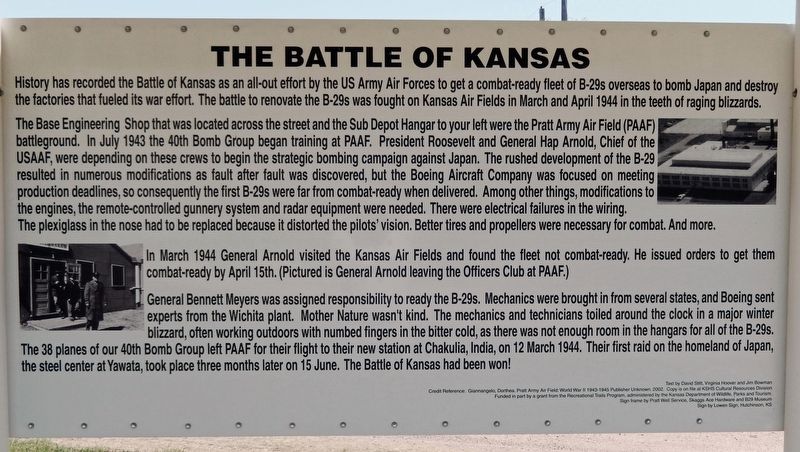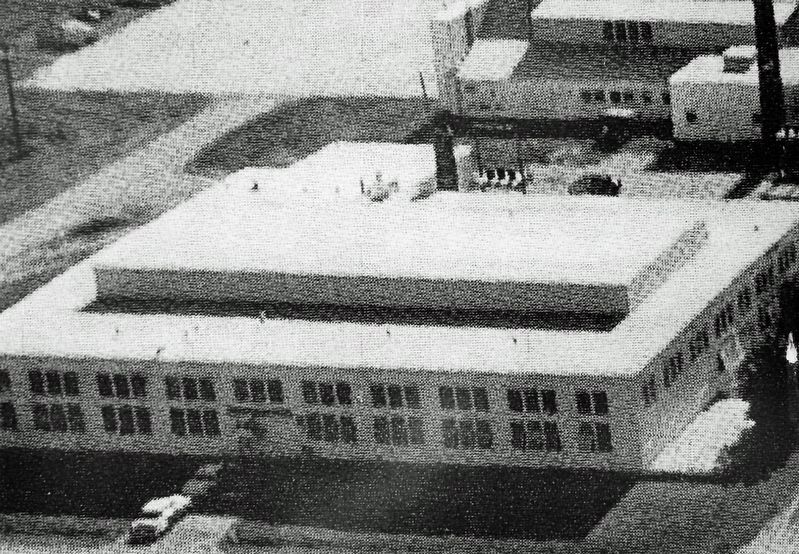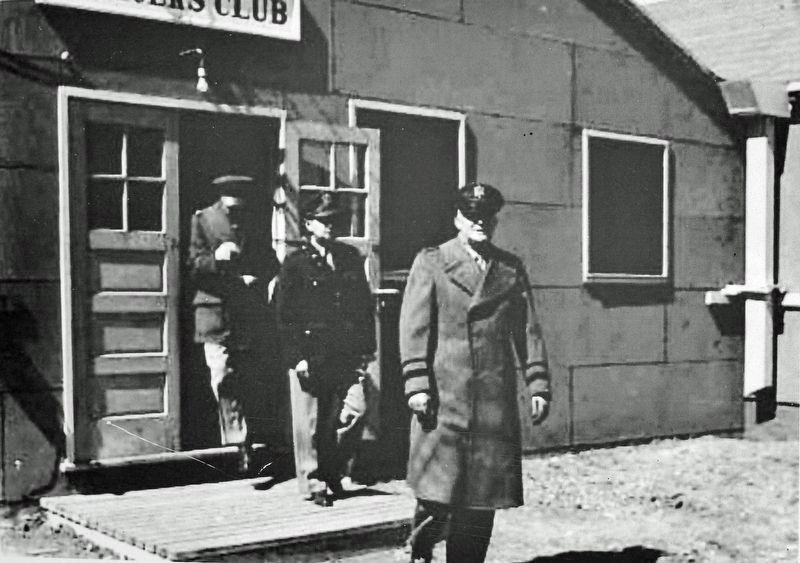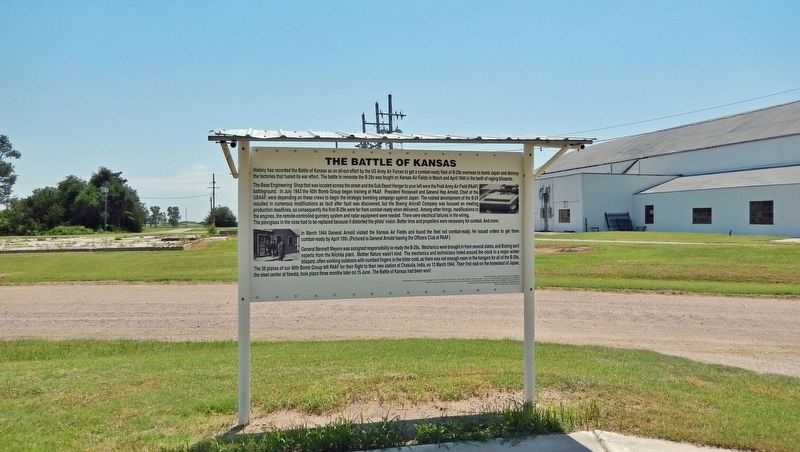Pratt in Pratt County, Kansas — The American Midwest (Upper Plains)
The Battle of Kansas
History has recorded the Battle of Kansas as an all-out effort by the US Army Air Forces to get a combat-ready fleet of B-29s overseas to bomb Japan and destroy the factories that fueled its war effort. The battle to renovate the B-29s was fought on Kansas Air Fields in March and April 1944 in the teeth of raging blizzards.
The Base Engineering Shop that was located across the street and the Sub Depot Hangar to your left were the Pratt Army Air Field (PAAF) battleground. In July 1943 the 40th Bomb Group began training at PAAF. President Roosevelt and General Hap Arnold, Chief of the USAAF, were depending on these crews to begin the strategic bombing campaign against Japan. The rushed development of the B-29 resulted in numerous modifications as fault after fault was discovered, but the Boeing Aircraft Company was focused on meeting production deadlines, so consequently the first B-29s were far from combat-ready when delivered. Among other things, modifications to the engines, the remote-controlled gunnery system and radar equipment were needed. There were electrical failures in the wiring. The plexiglass in the nose had to be replaced because it distorted the pilots' vision. Better tires and propellers were necessary for combat. And more.
In March 1944 General Arnold visited the Kansas Air Fields and found the fleet not combat-ready. He issued orders to get them combat-ready by April 15th. (Pictured is General Arnold leaving the Officers Club at PAAF.)
General Bennett Meyers was assigned responsibility to ready the B-29s. Mechanics were brought in from several states, and Boeing sent experts from the Wichita plant. Mother Nature wasn't kind. The mechanics and technicians toiled around the clock in a major winter blizzard, often working outdoors with numbed fingers in the bitter cold, as there was not enough room in the hangars for all of the B-29s. The 38 planes of our 40th Bomb Group left PAAF for their flight to their new station at Chakulia, India, on 12 March 1944. Their first raid on the homeland of Japan, the steel center at Yawata, took place three months later on 15 June. The Battle of Kansas had been won!
Text by David Stitt, Virginia Hoover and Jim Bowman
Credit Reference: Giannangelo, Dorthea. Pratt Army Air Field: World War II 1943-1945 Publisher Unknown. 2002. Copy is on file at KSHS Cultural Resources Division
Funded in part by a grant from the Recreational Trails Program, administered by the Kansas Department of Wildlife, Parks and Tourism.
Sign frame by Pratt Well Service, Skaggs Ace Hardware and B29 Museum.
Sign by Lowen Sign, Hutchinson. KS
Erected by Kansas Department of Wildlife, Parks and Tourism; B-29 Museum; City of Pratt; and Airport Authority.
Topics. This historical marker is listed in these topic lists: Air & Space • Education • War, World II. A significant historical month for this entry is March 1944.
Location. 37° 41.955′ N, 98° 44.532′ W. Marker is in Pratt, Kansas, in Pratt County. Marker is on Curran Road just west of Morris Avenue, on the right when traveling west. Marker is located at the south end of the Pratt Army Air Field Historical Walk, on the south side of the B-29 Bomber Museum. Touch for map. Marker is at or near this postal address: 82 Curran Road, Pratt KS 67124, United States of America. Touch for directions.
Other nearby markers. At least 8 other markers are within walking distance of this marker. Sub-Depot Hanger (Hanger #1) (within shouting distance of this marker); Historical WW II Parachute Building (within shouting distance of this marker); Victory Gardens & Rationing (about 400 feet away, measured in a direct line); Norden Bombsight Vaults (approx. 0.3 miles away); The City of "PAAF-Ville" (approx. 0.3 miles away); Base Operations Building (approx. 0.3 miles away); Aircraft Control Tower (approx. 0.3 miles away); Link Aviation Flight Simulation Trainer (approx. 0.3 miles away). Touch for a list and map of all markers in Pratt.
Related markers. Click here for a list of markers that are related to this marker. Pratt Army Air Field Historical Walk
Also see . . .
1. Battle of Kansas (Wikipedia). Excerpt:
The Battle of Kansas (also known as the "Battle of Wichita") was the nickname given to a project to build, modify, and deliver large quantities of the world's most advanced bomber to the front-lines, originally in Europe and also in the Pacific, although because of delays in production, it was used only in the Pacific. The battle began as the first B-29 Superfortresses rolled off the production lines of the massive new Boeing factory on the prairies near Wichita, Kansas.(Submitted on August 8, 2023, by Cosmos Mariner of Cape Canaveral, Florida.)
2. The Battle of Kansas. Excerpt:
General of the Army H. H. Arnold, chief of the air force, had already worked out a schedule for the bombing of Japan. On March 9, 1944, he arrived at the Smoky Hill Army Airfield at Salina and asked how many bombers could leave next day for India "as ordered." Because of the alterations the answer was "None." According to the Post, Arnold thereupon "exploded a string of `impossible' orders that set phones jangling all over the country," and "so began an uproar famed as the Salina Blitz, or The Battle of Kansas. Overnight, Kansas swarmed with tough colonels. G. I. mechanics flew in from a dozen states, and Boeing sent 600 civilian experts from the Wichita plant. Maj. Gen. Bennett E. Meyers gave them the pitch: No paperwork except simple notes of work done; hours would be as long as a man could stand on his feet; the last plane must fly away April fifteenth.(Submitted on August 8, 2023, by Cosmos Mariner of Cape Canaveral, Florida.)
Credits. This page was last revised on August 8, 2023. It was originally submitted on August 8, 2023, by Cosmos Mariner of Cape Canaveral, Florida. This page has been viewed 139 times since then and 74 times this year. Photos: 1, 2, 3, 4. submitted on August 8, 2023, by Cosmos Mariner of Cape Canaveral, Florida.



